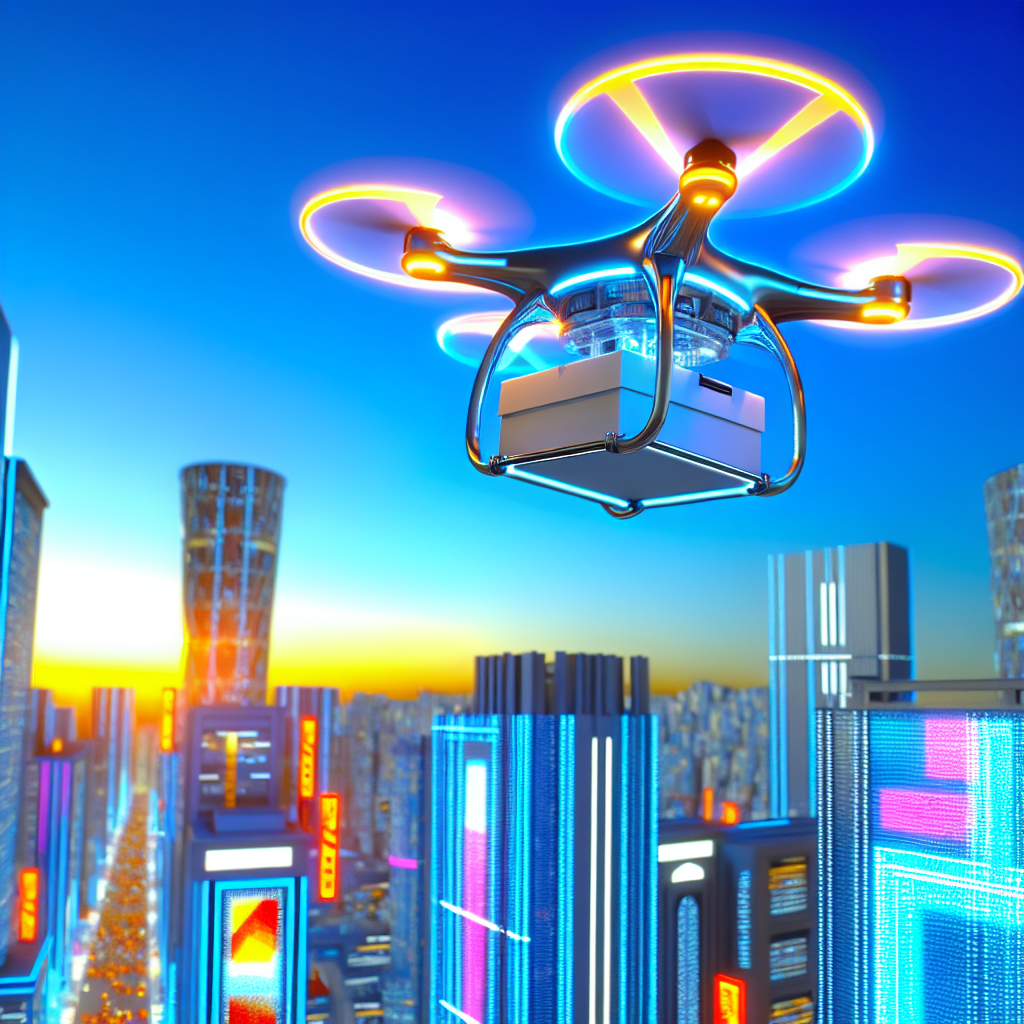Drone delivery is reshaping the logistics landscape, promising to deliver goods at unprecedented speed and efficiency. With the Federal Aviation Administration (FAA) recently proposing new regulations, the path is clearing for delivery drones to operate beyond the line of sight of their operators. As retailers like Walmart and Amazon scale up their drone services, consumers could soon expect packages to land on their doorsteps within minutes, revolutionizing last-mile delivery. The buzz around Walmart’s drone delivery initiatives and Amazon Prime Air showcases the growing interest in this innovative transport solution. Coupled with advancements in drone technology, the future of drone delivery appears brighter than ever, promising aim for improved customer satisfaction and convenience.
Unmanned aerial vehicles are transforming how we approach logistics and package distribution, signaling a new era of convenient transportation solutions. With an emphasis on efficiency, these airborne delivery systems are designed to provide instant services across urban and suburban areas. Major players in the market, such as Walmart and Amazon, are investing in aerial fleet capabilities to expedite deliveries, highlighting the appeal of drone technology. Enhanced FAA regulations are paving the way for broader adoption of these services, allowing more households to benefit from quick and reliable delivery. As consumer demand for fast service increases, the world of drone logistics is rapidly evolving to meet the needs of a tech-savvy society.
The Rise of Delivery Drones in the U.S.
Delivery drones are on the brink of transformation in the United States, with new FAA regulations that will pave the way for broader implementation. As companies like Walmart and Amazon invest heavily in drone technology, the potential for these flying machines to revolutionize the delivery landscape is becoming increasingly tangible. With the authorization to operate beyond an operator’s line of sight, drone services can now reach more customers than ever before, shipping items efficiently across urban and suburban settings.
The proposed revisions to FAA regulations signal a major step forward in the integration of drones into commercial logistics. Currently, only a handful of organizations operate under special waivers to deliver goods directly to homes. However, these changes would allow numerous retailers to deploy delivery drones, bringing services right to consumers’ doorsteps, facilitating faster delivery times and more convenient shopping experiences.
Walmart’s Expanding Drone Service
Walmart is taking strides towards a more expansive drone delivery system, collaborating with Wing, a subsidiary of Alphabet. This partnership is set to enhance the customer experience by delivering products from local stores directly to homes in an efficient manner. With plans to increase operational locations from 18 to 100 stores across major cities, Walmart is strongly positioning itself as a leader in the drone delivery market.
The strategic choice to commence service in bustling cities like Atlanta and Tampa is highly significant. It opens up new avenues for convenience as customers can receive essential items, such as groceries or household supplies, in a remarkably short timeframe. This expansion is not just a technological achievement but a major competitive move to cater to the evolving expectations of modern consumers.
Amazon’s Ambitious Drone Delivery Program
Amazon Prime Air is pushing the boundaries of drone technology with its ambitious goals to deliver packages autonomously. Initiating its drone delivery testing in College Station, Texas, in late 2022, Amazon aims to expand its services to cities such as Dallas and Kansas City. This move positions Amazon at the forefront of the e-commerce sector, leveraging drone capabilities to enhance customer satisfaction through rapid deliveries.
Unlike traditional delivery systems, which often face logistical hurdles, Amazon’s drone fleet promises to mitigate delays and provide a seamless delivery experience. With FAA approval for operations beyond pilot sight, Amazon’s commitment to making aerial delivery a commonplace reality showcases the immense potential that drone technology holds in reshaping consumer habits across the nation.
Unique Advantages of Drone Deliveries
The unique advantages of drone deliveries are increasingly drawing attention from both retailers and customers. Speed is a primary benefit, as evidenced by Walmart’s ability to deliver a pint of ice cream before it melts. This capability can redefine how we think about delivery times, especially for perishable goods, as drones can maneuver through urban environments faster than traditional vehicles.
Additionally, drones can reach customers who live in areas with challenging access, making it possible to deliver items in places even a delivery truck might struggle to navigate. This innovation presents numerous opportunities for retail companies to enhance their service offerings and cater to a broader audience, driving sales and fostering customer loyalty as convenience takes precedence in shopping habits.
Challenges and Potential of Drone Deliveries
While the future of drone deliveries looks promising, several challenges must be addressed before they become ubiquitous. Regulatory hurdles have historically stymied the rapid rollout of this technology, leaving some companies frustrated as they navigate the complex framework of FAA regulations. Yet, as the agency revises its rules, the landscape appears to be shifting, offering hope that widespread adoption is on the horizon.
Moreover, practical issues such as inclement weather and the need for trained operators can complicate drone operations. Despite these challenges, the industry remains optimistic that improvements in technology and regulatory frameworks will meet the demands of consumers. The evolution of drone delivery could potentially transform the logistics industry, making it more responsive to the needs of everyday customers.
Consumer Reception Towards Drone Deliveries
Consumer reception of drone deliveries has been surprisingly positive, with users expressing enthusiasm for the convenience and novelty these services offer. While some individuals harbor privacy and safety concerns about drones flying over residential neighborhoods, many have embraced the technology for its speed and efficiency. For example, Janet Toth from Frisco, Texas, shared her satisfaction with drone services, highlighting how they simplify everyday errands.
As drone delivery services continue to expand, companies like DoorDash report a complex relationship between traditional human deliveries and emerging drone technology. While some fear that automation may replace human jobs, there appears to be a growing consumer trend that favors both methods, suggesting that drone service enhancements could coincide with sustained demand for human delivery drivers.
The Role of FAA Regulations in Drone Delivery
The role of the FAA in shaping the future of drone delivery cannot be overstated. As the primary regulatory body for aviation in the United States, the FAA’s new proposed rule changes aim to create a more efficient framework for commercial drone operations. By allowing flights beyond the operator’s visual line of sight, the agency is paving the way for wider adoption of drone services across various sectors.
These adjustments not only alleviate the regulatory blockages that have previously hindered development but also encourage more retailers to consider drone solutions as a viable option for last-mile delivery. The FAA is crucial in balancing innovation with safety, ensuring that this transformative technology integrates smoothly into existing airspace and operational guidelines.
The Future of Drone Deliveries: What Lies Ahead?
As we look towards the future, the potential for drone deliveries seems limitless. With companies like Walmart and Amazon leading the charge, it’s essential to consider how these innovations will reshape the delivery landscape. Imagine a scenario where you could receive your online order within minutes of clicking ‘purchase,’ revolutionizing your shopping experience and setting new expectations for speed and convenience.
Moreover, the advancement of drone delivery extends beyond convenience; it also holds the promise of improving access to goods for remote or underserved communities. The expansion of drone services could level the playing field by providing faster delivery options to areas that have traditionally faced logistical challenges, thereby enhancing the overall consumer landscape.
Innovations Driving the Future of Drone Services
Innovation continues to be a cornerstone of the drone delivery industry, influencing everything from their design to the technology enabling safe autonomous flights. Advances in battery life, payload capacities, and navigation systems have made it more feasible for retailers to adopt drone services as a standard delivery option. These innovations open up new possibilities that were previously deemed impractical or too costly.
Companies are continuously exploring novel solutions to optimize drone functionalities and overcome existing limitations. In addition to enhancing efficiency, these advancements are vital in ensuring the safety and reliability of drone operations as they integrate into daily life, setting the stage for a more connected and responsive logistics ecosystem.
Competitive Landscape: Key Players in Drone Deliveries
The competitive landscape in the drone delivery sector is becoming increasingly crowded, with major players like Walmart and Amazon striving for dominance. These retail giants are leveraging their extensive logistics networks and technological know-how to implement drone delivery systems, creating an increasingly competitive atmosphere that drives innovation and improves service offerings.
Startups like Zipline and Flytrex are also significant players, carving out niches in medical supply delivery and urban logistics, respectively. As these companies continue to innovate and adapt, the overall market for drone deliveries is likely to grow, ensuring that consumers have access to fast, efficient delivery options no matter where they are located.
Frequently Asked Questions
What are drone delivery services and how do they work?
Drone delivery services utilize unmanned aerial vehicles (UAVs) to transport packages and goods from retailers to customers. This innovative delivery method allows for rapid shipment, often within minutes, benefiting companies like Walmart and Amazon Prime Air. Drone services operate by navigating pre-defined routes, using GPS and mapping technology, to reach the customer’s location efficiently.
What are the latest FAA regulations regarding delivery drones?
The latest FAA regulations propose simplifying the operational rules for delivery drones, allowing them to operate beyond the pilot’s line of sight. This change would enable companies like Amazon and Walmart to expand their drone delivery services to more areas, potentially increasing access for millions of U.S. households.
How does Walmart’s drone delivery service work?
Walmart’s drone delivery service, operated in partnership with Wing, delivers items from select stores directly to customers’ doorsteps. Currently available in the Dallas area, the service is set to expand to 100 more stores by next summer, allowing for quicker delivery of various products, including groceries and household essentials.
What is Amazon Prime Air and where is it operational?
Amazon Prime Air is Amazon’s drone delivery service that aims to deliver packages within 30 minutes using autonomous drones. As of now, it has successfully launched in College Station, Texas, and has expanded to suburban Phoenix, with plans to continue growth into major cities like Dallas and Kansas City.
What challenges do delivery drones face in the U.S.?
Despite the potential of delivery drones, they face challenges such as regulatory hurdles, weather conditions affecting flight safety, and the need for skilled operators. Additionally, public concerns about privacy and safety play a role in the slow adoption of drone delivery services.
Are consumers satisfied with drone delivery services?
Consumer reception towards drone delivery services has been largely positive. Many users appreciate the convenience and speed of delivery. For instance, Janet Toth from Frisco, Texas, has endorsed the service, highlighting its novelty and effectiveness. However, some residents do express concerns regarding privacy.
How much does it cost to deliver a package using a drone compared to traditional methods?
The cost to deliver a package by drone currently averages around $13.50, which is significantly higher than traditional vehicle delivery costs of about $2. However, as technology advances and operational efficiency improves, these costs are expected to decrease.
Which companies are leading in drone delivery innovation?
Besides Walmart and Amazon, companies like Zipline and Flytrex are pioneers in the drone delivery sector. Zipline has made significant strides in delivering medical supplies in Rwanda, while Flytrex has provided drone delivery services to residents in Iceland since 2017.
What impact do delivery drones have on traditional delivery jobs?
While there are concerns about job displacement due to the rise of drone delivery services, companies like DoorDash report an increase in demand for human delivery drivers, suggesting that drones may complement rather than replace traditional delivery roles.
What items are commonly delivered by drones?
Delivery drones are currently transporting a variety of items, including groceries and everyday consumer goods such as ice cream and candy bars. Companies are experimenting with different product types to find the most efficient logistics solutions for drone delivery.
| Key Point | Details |
|---|---|
| FAA Rule Proposal | New rules to ease drone operations beyond the operator’s line of sight, allowing more companies to utilize drone deliveries. |
| Current Usage | Currently limited to a few companies with waivers, mainly in suburban and rural areas. |
| Walmart’s Expansion | Walmart partners with Wing to expand drone deliveries from 18 to 100 stores in major cities by next summer. |
| Amazon’s Development | Amazon’s Prime Air service has expanded to various areas and operates autonomous drones beyond line of sight. |
| Early Adopters | Companies like Zipline and Flytrex have been pioneers, with significant accomplishments in medical deliveries and household services. |
| Challenges Faced | Regulatory hurdles and high delivery costs compared to traditional methods are current challenges for drone delivery. |
| Consumer Sentiment | Mixed reception with some privacy concerns, but many users appreciate the convenience. |
| Job Market Impact | Despite fears, demand for human deliveries has increased alongside drone services. |
Summary
Drone delivery is poised for significant growth in the coming years thanks to evolving regulations and technological advancements. As the FAA moves to simplify drone operations, retail giants like Walmart and Amazon are ready to expand their services, bringing convenience to millions of households across the U.S. Despite facing challenges like regulatory hurdles and consumer privacy concerns, the overall sentiment toward drone deliveries remains positive. With successful implementations already seen in various countries and the growing acceptance among consumers, drone delivery is on the verge of becoming an integral part of our everyday logistics.
Source: https://www.ocregister.com/2025/08/12/drone-deliveries/
### Transform Your Space: Enhancing Homes in Orange County
Homeowners in Orange County are continually seeking ways to elevate their living spaces and invest in properties that reflect their lifestyle. With a median home value of approximately $1.18 million, residents in affluent areas such as Laguna Beach, Newport Beach, and Irvine are ready to embark on renovation projects that surpass $50K. This article explores ways to enhance your home while remaining aware of local regulations and opportunities for contractors.
### Embracing Orange County’s Unique Architectural Styles
When considering a remodeling project in OC, homeowners should first focus on the unique architectural styles that characterize their neighborhoods. From the coastal charm of Laguna Beach to the modern elegance found in Costa Mesa, contractors who understand local aesthetics can provide invaluable guidance to homeowners. Remodeling projects that enhance or complement the existing architecture—whether it’s a beach bungalow or a contemporary villa—can significantly improve a home’s value.
### Navigating California Building Codes and Permits
Before starting any remodeling project in Orange County, contractors and homeowners must navigate the local building codes and obtain necessary permits. California’s stringent regulations are designed to ensure safety and sustainability. Each city, including Huntington Beach and Costa Mesa, may have unique codes that specify guidelines on structural changes, energy efficiency, and more. For contractors, understanding these requirements can present business opportunities, as many homeowners may seek professional assistance to avoid costly delays and fines.
### Climate Considerations in OC Remodeling Projects
The unique climate of Orange County, known for its mild coastal weather, should guide homeowners in their remodeling decisions. For instance, outdoor living spaces, such as patios and decks, can be designed to withstand the occasional rainy season while maximizing sunny days. Contractors can capitalize on this by recommending durable materials that reflect the regional climate, further appealing to homeowners looking to create functional outdoor spaces.
### Unique Opportunities for OC Contractors
As the demand for high-value renovations grows among Orange County homeowners, local contractors have a tremendous opportunity to expand their services. Offering specialized packages that include eco-friendly materials or smart home technology can attract clients looking to increase their home’s sustainability and efficiency. Additionally, focusing on neighborhoods with high turnover rates can enable contractors to connect with new homeowners eager to personalize their recent purchases.
### Conclusion: Engage with Your Local Community
In conclusion, if you’re a contractor or remodeler in Orange County, leveraging local knowledge not only enhances your credibility but opens up multiple business avenues. By understanding the unique market needs and staying updated on regulations and climate considerations, you can position yourself as a trusted partner for homeowners embarking on transformative renovations. Engage with the community through local events or social media to build your reputation and encourage homeowners to reach out for their renovation needs.






